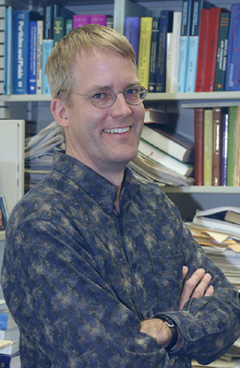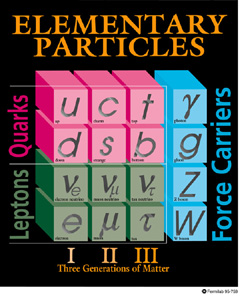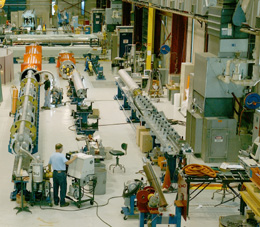 |
|
Crisis in Physics? by Joseph Lykken This article first appeared in the November issue of PHYSICS TODAY. Respond online at http://www.fnal.gov/pub/ferminews/interactions/index.html or send email to ferminews@fnal.gov.
Physics has a lot in common with the U.S.economy: Both have flourished during the past century beyond the wildest dreams of even the most sanguine prognosticators. But even in good times, we worry about the future. Indeed, in physics, we are as often discouraged by discovery as we are by failure. Looking back at the glorious achievements of past decades, we are nervous that our success is a tough act to follow. Looking to the future, our drive to answer increasingly ambitious questions continually ups the ante needed to move ahead, increases the competitive pressures within our field, and stresses everybody out. Is it fair to assert that physics is in crisis? Certainly physicists in the U.S. do face a crisis of funding; many years of flat research budgets and even flat-flat (that is, constant-dollar) budgets, have slowed and discouraged the new initiatives that constitute the future of U.S.physics. Another decade of stagnant or declining funding would eliminate any pretense of the U.S. as a world leader in physics research. That loss would be a terrible outcome both for physics and for the long-term prosperity and security of the U.S. SELF-FULFILLING PROPHECIES A good first step is to splash a little cold water in our faces and examine our own attitudes and rhetoric about our field. Ironically, one of the main reasons for stagnant research funding in U.S. physics is a lack of confidence among physicists themselves, despite the fact that worldwide, physics research on all fronts is as exciting as it has ever been. Too many physicists have accepted and even promulgated the notion that our field is in an intellectual crisis — that we have somehow lost momentum or motivation. That notion is demonstrably false, but if we don’t stop bandying it about, we are likely to find it a self-fulfilling prophecy. In my own field, particle physics, we are guilty of especially sloppy thinking. When we speak about a so-called crisis in particle physics, we are actually invoking a state of affairs that has existed for 20 years. It began when key experiments led to general acceptance of the standard model of strong and electroweak particle interactions. Suddenly, we had a powerful theory that could explain any high-energy experiment we threw at it, a theory so rich and dense that we are still puzzling out its physical implications. That watershed was itself the resolution of a previous two-decade period, when particle physics had been plagued by a plethora of new particles and particle properties, with only a patchwork of theoretical concepts to account for them. Instead of too many surprises, we graduated to having too few surprises. Of course, the problem of the standard model is, in reality, the triumph of the standard model. Any group of scientists should be so lucky as to develop a framework so powerful that it takes decades to assimilate it. Not only are we in particle physics guilty of mislabeling triumph as crisis, we have also managed to confuse and conflate those healthy developments with a genuine failure: the cancellation of the Superconducting Super Collider project, which indeed was a mighty blow to the aspirations of U.S.high-energy physics. But now that a decade has passed, we see quite clearly that the failure has been overcome. A supercollider is in fact being built: the Large Hadron Collider at CERN. The supercollider is not a mistake; it is a great idea. The European high-energy physics community seized the opportunity to build this collider and has happily bet its future on it. The LHC project involves an unprecedented U.S.- Europe collaboration, the success of which has accelerated the internationalization of physics. Meanwhile, the U.S.- based high-energy physics program has diversified and exploited new opportunities in the physics of neutrinos and of heavy quarks. U.S. physicists have become the world’s innovators for exploring the connections between particle physics and astrophysics, and we have revamped the Tevatron collider complex to provide another decade of exploration at the energy frontier. In terms of the questions we can ask and expect to answer, particle physics has never been richer.
THE UNITY AND DIVERSITY OF PHYSICS Physics as an intellectual pursuit is simply defined as the study of the structure and forms of matter and of the attendant interactions. All physicists share a common set of problem-solving tools and a common base of knowledge. We also share what Gerald Holton of Harvard University calls the Ionian Enchantment, a conviction — passed down from Ionian philosopher Thales of Miletus — that the world is orderly and that it can be explained by a small number of natural laws.1 In physics, we also have a common language, mathematics, that has been responsible in large part for the spectacular pace of theoretical advances in our field. As Eugene Wigner wrote,“The miracle of the appropriateness of the language of mathematics for the formulation of the laws of physics is a wonderful gift which we neither understand nor deserve.”2 There is, in physics, an intellectual unity that we should all recognize and cherish. Yet, because of the staggering exponential growth in our knowledge, research in physics has become an extraordinarily complex and diverse activity. Thus, physics as a human activity is not unified, nor can it ever be. The day is long gone when a single person could keep up with all of the advances in all branches of physics. Indeed, I can cheerfully assert that neither I nor any of my colleagues can hope to adequately understand all of the technical developments in particle physics alone. Want to know what is happening in my field? You can catch up by downloading the top-cited papers from the SPIRES HEP archive,3 that is, only those papers important enough to be cited 50 or more times in other papers. There are 17,084 such papers; 1,644 of them are not even five years old. As we have extended the radius of our knowledge, so too have we increased the circumference of our ignorance. That is a good thing. Civilizations are vastly smarter than any individual within them, and get smarter through the cumulative efforts of thousands of talented people. That lever truly moves mountains. CELEBRATING SUCCESS The danger, naturally, is that physicists feel — and are — increasingly detached from anything beyond their own research. Because it would be neither practical nor wise to subdivide every university physics department into five or six components, we had better try harder to maintain good intellectual connections with our colleagues in other areas of physics. But that is a practical problem, not a reason or excuse for ideological wrangling. Poor attendance, a distressingly common phenomenon at departmental colloquia, is best addressed by recognizing that physicists are busy people. A little prodding and peer pressure — and better colloquia — can solve this problem. While we are improving our relations across subfields, let’s refrain from indulging in debates about whose research is more attractive or is more in sync with postmodern mores. In some quarters, for example, it may be fashionable to attack reductionism, but it makes little sense for physicists to do so. Reductionism in physics is not a cult dogma; it is a tool, and we need it. As the great biologist Edward O. Wilson pointed out, reductionism “is the search strategy employed to find points of entry into otherwise impenetrably complex systems.”4 Take it apart, break it down, simplify, model. As such, says Wilson,“reductionism is the primary and essential activity of science.” There are, of course, other essential approaches. Consider the reply of physicist Maria Spiropulu to a question asked about reductionism at the 2001 Arthur H.Compton lecture series: “Research in science is like food. Sometimes you want a nice reduction with lots of cooking, and sometimes you just want sushi.” By the same token, physicists should avoid denigrating the wondrous features of other subfields. We celebrate that particle physics is addressing an amazingly ambitious slate of fundamental questions. We celebrate condensed matter physics for combining unsurpassed intellectual challenges with unlimited possibilities for technological application. We celebrate that astrophysics and cosmology have entered a golden age of data and discovery. We celebrate and nurture new subfields,and the connections and overlaps across existing disciplines.
We admit that physics is expensive. Look at gravity physics, a field that, for decades, consisted of a few cheap tabletop experiments and a few theorists. Now, with the advent of the Laser Interferometer Gravitational-Wave Observatory, the gravity program is competing for the big dollars. As Kip Thorne of Caltech put it,“Do you think I ’m happy that LIGO costs 300 million dollars? I’m not! But that’s what it costs to do it.”5 We should be proud that basic research in physics is a major undertaking of our civilization. It’s difficult, it’s expensive, and it requires a huge cadre of brilliant minds. Is it useful? Is it worth it? A century and a half ago, Michael Faraday was asked of what use was his discovery of electromagnetic induction. His reply: “Of what use is a child?”6 Physics research continues to supply some of the great adventures of our time. We physicists can do a better job of communicating this simple message.
References
|


